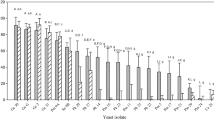Abstract
A strain QY229, which produces a milk-clotting enzyme, was screened from red kojic rice, a Chinese traditional natural food colorant and preservative for meat and fish for centuries. This strain was identified as Quambalaria cyanescens (QY229) based on morphology and internal transcriptional spacer sequence. Inhibition assay by pepstatin A at 10 μM proved it to be an aspartate proteinase. This is the first report about Quambalaria cyanescens producing milk-clotting enzymes.




Similar content being viewed by others
Abbreviations
- PMSF:
-
Phenylmethylsulphonyl fluoride
- E-64:
-
Trans-epoxysuccinyl-l-leucylamido (4-guanidino) butane
- EDTA:
-
Ethylenediaminetetraacetic acid
- MCA:
-
Milk-clotting activity
- PA:
-
Proteolytic activity
- IDF:
-
International dairy federation
- IMCU:
-
International milk clotting units
References
Isam AMA, Isao M, Elfadil EB, Nobuhiro M (2009) Characterization of partially purified milk-clotting enzyme from Solanum dubium Fresen seeds. Food Chem 116:395–400
Winwood J (1989) Rennet and rennet substitutes. Int J Dairy Technol 42:1–2
Lopes A, Teixeira G, Liberato MC, Pais MS, Clemente A (1998) New vegetal sources for milk clotting enzymes. J Mol Catal B-Enzym 5:63–68
Veríssimo P, Esteves C, Faro C, Pires E (1995) The vegetable rennet of Cynara cardunculus L. contains two proteinases with chymosin and pepsin-like specificities. Biotechnol Lett 17:621–626
Cavalcanti MTH, Teixeira MFS, Lima FJL, Porto ALF (2004) Partial purification of new milk-clotting enzyme produced by Nocardiopsis sp. Bioresource Technol 93:29–35
Shieh CJ, Phan Thi LA, Shih IL (2009) Milk-clotting enzymes produced by culture of Bacillus subtilis natto. Bioche Eng 43:85–91
Silveira GG, Oliveira GM, Riberieo EJ, Monti R, Contiero J (2005) Microbial rennet produced by Mucor miehei in solid-state and submerged fermentation. Braz Arch Biol Techn 48:931–937
Preetha S, Boopathy R (1994) Influence of culture conditions on the production of milk-clotting enzyme from Rhizomucor. Word J Microb Biot 10:527–530
Carels M, Shepherd D (1977) The effect of different nitrogen sources on pigment production and sporulation of Monascus sp., in submerged shaken culture. Can J Microbio 23:1360–1372
Arima K, Iwasaki S, Tamura G (1967) Milk clotting enzyme from microorganisms. Part I: screening test and identification of the potent fungus. J Agr Biol Chem 31:540–545
DF I (2002) Milk and milk products—Microbial coagulants—Determination of total milk-clotting activity. IDF Standard 176. International Dairy Federation, Brussels, Belgium
Official Methods of Analysis, People’s Republic of China Professional Standard, China (1988) SB/T 10317-1999
Zhou DQ (2006) Microbiology experimental textbook. Higher education Press, Beijing, China
Sambrook J, Russell DW (2002) Molecular cloning: a laboratory manual, 3rd edn. Science Press, Beijing, China
Ageitos JM, Vallejo JA, Sestelo ABF, Poza M, Villa TG (2007) Purification and characterization of a milk-clotting protease from Bacillus Licheniformis strain USC13. J Appl Microbiol 10:2205–2213
Lu FX, Sun LJ, Lu ZX, Bie XM, Fang YW, Lu S (2007) Isolation and Identification of an endophytic strain EJS-3 producing novel fibrinolytic enzymes. Curr Microbiol 54:435–439
Wei JC (1979) Handbook of Fungal Identification. Shanghai Science and technological Press, Shanghai, China
Beltrame-Botelho IT, Gaspar-Silva D, Steindel M, Davila AM, Grisard EC (2005) Internal transcribed spacers (ITS) of Trypanosoma rangeli ribosomal DNA (rDNA): a useful marker for inter-specific differentiation. Infect Genet Evol 5:17–28
Healy M, Reece K, Walton D, Huong J, Shah K, Kontoyiannis DP (2004) Identification to the species level and differentiation between strains of Aspergillus clinical isolates by automated repetitive-sequence-based PCR. J Clin Microbiol 42:4016–4024
Ocón E, Gutiérre AR, Garijo ZP, Tenorio C, López I, López R, Santamaría P (2010) Quantitative and qualitative analysis of non-Saccharomyces yeasts in spontaneous alcoholic fermentations. Eur Food Res Technol 230:885–891
Garg SK, Johri BN (1994) Rennet: current trends and future research. Food Reviews International 10:313–355
Tubesha ZA, Al-Delaimy KS (2003) Rennin-like milk coagulant enzyme produced by a local isolate of Mucor. Int J Dairy Technol 56:237–241
Acknowledgments
This work was supported by the Shandong Province Science and Technology Tackle Project (Grant no: 2007GG20010004).
Author information
Authors and Affiliations
Corresponding author
Rights and permissions
About this article
Cite this article
Zhang, Z., Wang, C., Yao, Z. et al. Isolation and identification of a fungal strain QY229 producing milk-clotting enzyme. Eur Food Res Technol 232, 861–866 (2011). https://doi.org/10.1007/s00217-011-1454-4
Received:
Revised:
Accepted:
Published:
Issue Date:
DOI: https://doi.org/10.1007/s00217-011-1454-4




